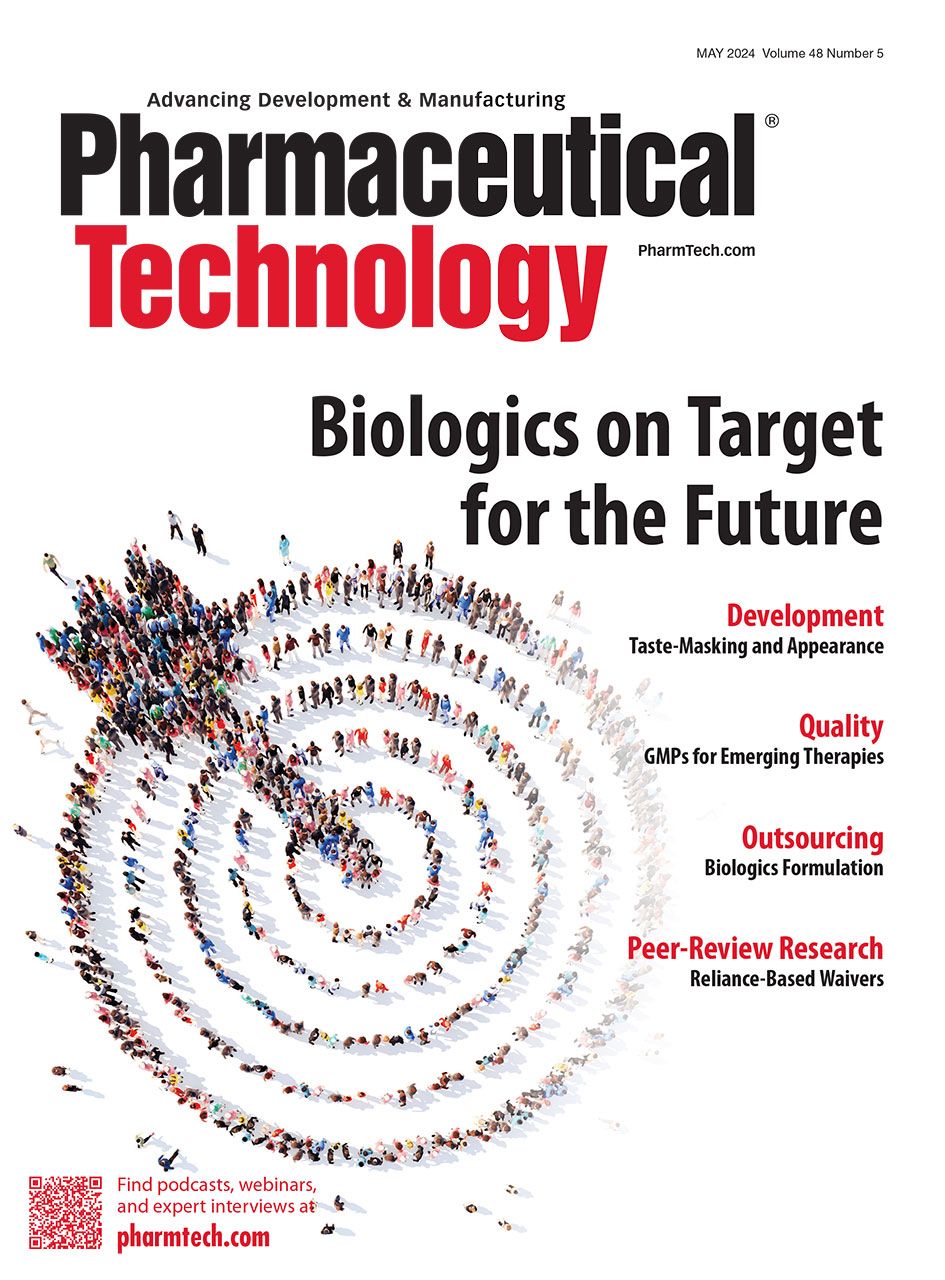Compared with small-molecule therapies, which have been in use for more than a century, the field of biological therapies is reasonably nascent. Since the approval of the first recombinant protein in the 1980s, numerous biological therapies have been developed for a variety of indications (1).
“The field of biological therapies has indeed experienced a significant expansion and transformation, largely driven by advancements in molecular and cellular biology,” says Anupreet Kaur, post-doctoral associate in the Brinson Research Group, Institute for Bioscience and Biotechnology Research, National Institute for Standards and Technology, University of Maryland. “One of the key breakthroughs has been the widespread adoption of recombinant DNA technology, which has revolutionized the production of protein therapeutics.”
“[Going back to] the end of the last century, when there were mainly small-molecule drugs on the market, [patients were typically] suffering from major side effects,” notes Peter Timmerman, head of Peptide Science at Biosynth. “[These unwanted effects] paved the way for a new generation of drugs that were more specific and more biologically based.”
Targeted therapy
A major benefit of biological therapies is their ability to reach targets that have previously been thought of as ‘undruggable’ with more traditional small-molecule therapies (2). Despite being much larger than small-molecule drugs, biological therapies feature a greater affinity and selectivity to a specific target, making them more effective with less off-target toxicity, Timmerman explains.
Specificity to molecular targets is a key attribute of monoclonal antibodies (mAbs), remarks Kaur. “This specificity allows [mAbs] to distinguish between subtle differences, such as single amino acid variation and conformational changes, enabling precise targeting of disease-related molecules,” she says. “Additionally, the bivalency of each antibody molecule contributes to the higher binding strength, which enables mAbs to bind with exceptional affinities, typically ranging from picomolar to nanomolar levels.”
This high binding strength is important for differentiating between the binding partners and for enhancing the therapeutic efficacy of the mAbs, continues Kaur. “Moreover, the Fc [fragment, crystallizable] domains of mAbs play a crucial role in [biological] properties,” she adds. “This region can engage with various components of the immune system leading to functions such as antibody-dependent cellular cytotoxicity, or complete complement dependent cytotoxicity. These effector function-enhanced antibodies have the ability to eliminate the target cells and modulate the immune response, further improving therapeutic potential.”
Progress in 3D bioprinting
In an interview with Pharmaceutical Technology®, Bill Whitford, Strategic Solutions leader at Arcadis, spoke to the progress being made by 3D printing in commercial biologics production (1).
Having presented on the topic during one of the sessions at INTERPHEX 2024, Whitford highlighted the utility of 3D bioprinting for cell culture. “3D culture provides many unique capabilities; it’s more biomimetic,” he said in the interview. “Actually, there’s nothing natural about growing cells in monolayer on a styrene plate, so there are many 3D culture technologies that employ many different production methods that support many categories of application and individual products.”
Additionally, Whitford alluded to the potential use of 3D bioprinting for emerging therapies, such as cell and gene therapies. “The ability now—through site-directed CRISPR [clustered regularly interspaced short palindromic repeats]-type engineering—to drive the evolution of a cell towards exactly what phenotype is required is supporting the ability to … develop the bio ink … required to get the initial print job accomplished,” he said.
Reference
1. Spivey, C. Bill Whitford of Arcadis Discusses 3D Printing for Biologics (INTERPHEX 2024). PharmTech.com, April 16, 2024.
“As targets for mAb therapies are identified, fewer are agonist targets and more are antagonistic targets,” remarks Scott Rudge, founder of SynerG Biopharma Group. “When an agonist target is found, the antibody can be designed to stimulate a cell or an organ to produce a certain outcome.For example, insulin is a protein agonist, because it causes cells to take up glucose and store it as glucagon.”
However, antagonists, such as check point inhibitors, actually block something from happening, Rudge emphasizes. “If every receptor in the body needs to be inhibited or down-regulated in some way, antagonists are going to require ever increasing doses, which means higher concentration, to be administered subcutaneously or some other way less invasive than intravenous administration,” he adds.
“Subcutaneous and intramuscular delivery, in particular, require highly concentrated formulations, as the maximum volume these routes of administration can accommodate is about 1 mL,” Rudge explains. “Alternatively, other means for delivering high doses of mAbs could be found that deliver more than 1 mL. Research in these two areas is very active.”
Additionally, the development of bispecific antibodies represents a significant milestone for the biopharma industry, Kaur adds. “This platform holds promise for enhancing the efficacy, increasing the half-life, and improving the stability and specificity of biologic therapies, while minimizing the side effects,” she says.
Looking beyond antibody therapeutics, Kaur highlights RNA vaccines as a promising platform that will enable the development of novel vaccines to tackle infectious and other diseases. “Ongoing research aims to further optimise RNA vaccine platforms and expand their application beyond infectious diseases,” she says.
“Also, there are short oligonucleotide therapies, which will present a versatile and promising approach for the treatment of orphan rare diseases by targeting specific genes and other regulatory elements,” Kaur specifies. “Continued research and development efforts are focused on improving the delivery strategies, enhancing the specificity and efficacy, and expanding the clinical application of oligonucleotide-based therapeutics.”
An innovative future
Focusing on potential future trends for the biologics field, Hans de Backer, head of the Peptide Division, Biosynth, emphasizes that there are several key trends that will be ongoing for a long period of time. Some are more industry generalized trends, such as accelerating time-to-market and moving towards more green solutions in manufacturing; however, a more specific trend for biologics will be the drive for increasingly patient-specific solutions instead of generic ‘one-size-fits-all’ type therapies.
A further trend that is shaping the biologics sector is the development of combination therapies, whereby companies are developing these products as combination options from the outset rather than considering a potential combination later on, De Backer specifies. “The expanded range of biological and small-molecule drugs already approved can be being used during development to act on multiple pathways or the same pathways through differing mechanisms. It is therefore increasingly important for researchers to be able to access reagents (as biosimilars or generics) early in development to understand modes and mechanism of action, and routes for improving efficacy,” he says.
“All of the aforementioned trends will be mainly boosted by the introduction of artificial intelligence (AI), which is being seen in all areas playing a key role” De Backer says. In particular, he points out that AI is helping to accelerate time-to-market for drug development, all the way from discovery to production. AI is helping companies to deliver results that in turn are fitting in with funding cycles and ultimately helping them commercialize their drug products.
In terms of personalized medicine, AI will enable further personalized drug manufacture options—but also personalized prescription. AI can be used by clinicians to assess the sort of response they can expect from a therapy, which is allowing them to choose the best therapeutic option for their patients (3). “AI will definitely bring new opportunities and allow for better forecasts [of therapy outcomes], driving personalized medicine to the next level,” De Backer asserts.
Additionally, Timmerman states that he has high expectations of AI as it has the potential to provide information that hasn’t been seen before, particularly for drug discovery. Currently, when trying to look at the drug space, industry is limited to only a fraction of what is available, he emphasizes, whereas AI has the potential to be used to map out the complete drug space, enabling the identification of a greater number of novel chemical entities (4).
There are other areas where AI can provide new information, Timmerman notes. “For example, there is a new modeling program called AlphaFold that basically can predict the structure of all proteins from their primary amino acid sequences,” he says. “[So, now it is not necessary to have] any crystal structure or any other type of 3D structure to know how the protein looks and how to develop a drug against it.”
Recent research has also demonstrated the ability for AI and machine learning to speed up protein engineering (5,6). “Advancements in protein engineering have facilitated the development of novel molecular scaffolds, optimized molecular functions, and improved drug properties,” Kaur adds. “These molecule-level innovations have opened up new possibilities for creating biologics with enhanced therapeutic effects.”
“Gaining an in depth understanding of accepted and multiple antibody interactions will undoubtedly revolutionize the future of biological formulation, as this knowledge can lead to the design of excipients that have beneficial impacts on the protein structure, thereby improving quality and efficacy [of antibody therapeutics] in the future,” summarizes Kaur. “Moreover, understanding the dynamics of antibody and antigen binding properties at the molecule level will help in designing the effective next-level antibodies. Manipulating these binding properties can optimize antibody performance and specificity and affinity for specific application.”
References
1. Andrews, L; Ralston, S; Blomme, E.; Barnhart, K. A Snapshot of Biologic Drug Development: Challenges and Opportunities. Hum. Exp. Toxicol. 2015, 34 (12), 1279–1285.
2. Leach, M.W.; Rottman, J.B.; Hock, B.; et al. Immunogenicity/Hypersensitivity of Biologics. Toxicol. Pathol. 2014, 42 (1), 293–300.
3. Johnson, K.B.; Wei, W.-Q.; Weeraratne, D.; et al. Precision Medicin, AI, and the Future of Personalized Health Care. Clin. Transl. Sci. 2021, 14 (1), 86–93.
4. Duncan, K.K.; Rudnicki, D.D.; Austin, C.P.; Tagle, D.A. Exploring Novel Biologically-Relevant Chemical Space Through Artificial Intelligence: The NCATS ASPIRE Program. Front. Robot. AI, 2020, 6, 1–6. DOI: 10.3389/frobt.2019.00143
5. Wait, S.J.; Expòsit, M.; Lin, S. Machine Learning-Guided Engineering of Genetically Encoded Fluorescent Calcium Indicators. Nat. Comput. Sci. 2024, 4, 224–236.
6. Case, M.; Smith, M.; Vinh, J.; Thurber, G. Machine Learning to Predict Continuous Protein Properties from Binary Cell Sorting Data and Map Unseen Sequence Space. Proc. Natl Acad. Sci. USA 2024, 121 (11), e2311726121.
About the author
Felicity Thomas is the European/senior editor for Pharmaceutical Technology Group.
Article details
Pharmaceutical Technology
Vol. 48, No. 5
May 2024
Pages: 10–13
Citation
When referring to this article, please cite it as Thomas, F. Biologics on Target for the Future. Pharmaceutical Technology, 2024, 48 (5) 10–13.

